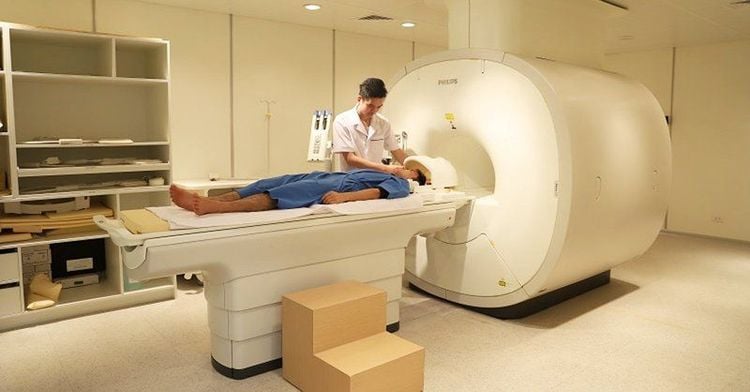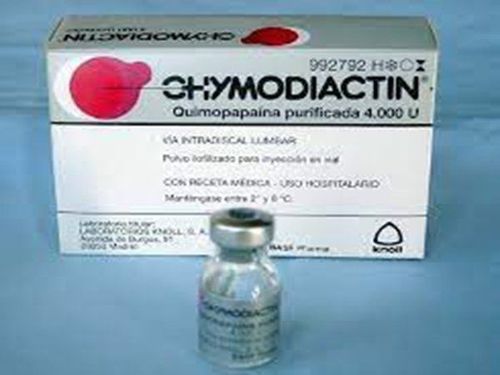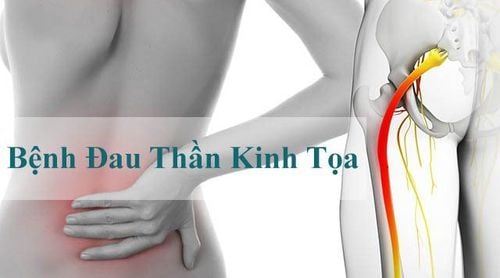This is an automatically translated article.
Sciatica is not only a common disease in the elderly, but it tends to be more common in young people. The difference between sciatica in young people and sciatica in the elderly mainly comes from the prevalence, causes, and symptoms of the disease.
1. What is sciatica?
The sciatic nerve is a nerve that runs along the lower back to the buttocks, knees, and legs. Sciatica (also known as sciatica) is a condition in which the nerve located at the end of the spinal cord is compressed, causing chronic low back pain, spreading down the leg along the path of the nerve. sit. The disease may be accompanied by other manifestations such as sensory disturbances, numbness or muscle atrophy.
Sciatica is often associated with low back pain, appears and increases when moving, standing, walking, coughing, sneezing, sitting for a long time,... According to statistics, sciatica is common in women gender than men. And if not treated promptly, the disease can cause muscle atrophy, even leading to lifelong paralysis.

Đau thần kinh tọa có thể gây liệt nếu không được điều trị sớm
2. The difference between sciatica in young and old people
Sciatica is common in both young people (18 - 28 years old) and the elderly. The difference of the disease between these two groups of subjects mainly lies in the incidence, causes and symptoms of the disease. Detail:
2.1 Incidence of disease
Sciatica is more common in the elderly than in the young.
2.2 Causes of disease
Sciatica in young people:
Causes of sciatica in young people are mainly due to spinal deviation, disc herniation, tumor, trauma, ... pressing on the sciatic nerve and causing pain. The subjects susceptible to this disease are usually:
People who do manual labor (loading goods, janitors) or dancers, weightlifters, etc. often have to do hard labor; Office workers sitting at the computer for too long lead to spinal degeneration, disc herniation, and compression of the sciatic nerve for a long time; Pupils, students in the learning process have sat in the wrong posture for a long time; People with an unreasonable diet, eating a lot of spicy, hot foods, alcoholic drinks, ... cause irritation of the sciatic nerve and lead to pain symptoms; People with a history of musculoskeletal disorders.

Nhân viên văn phòng dễ mắc thần kinh tọa do bị thoái hóa cuộc sống
Sciatica in the elderly:
In the elderly, body functions begin to age, health decline will lead to many different diseases, including sciatica. Common causes of sciatica in the elderly include:
Health goes down, the musculoskeletal system shows signs of weakness and degeneration; The appearance of bone spurs compressing the sciatic nerve causes constant dull pain from the back down to the knee; Herniated disc disease in the elderly causes the mucus in the bones and joints to bleed, stagnate at the sciatic nerve location, also strongly affect this nerve and cause numbness; The elderly have weak resistance, are often sedentary, have an unscientific diet, are prone to obesity, diabetes, etc., which directly affect the sciatic nerve.

Người già béo phì có nguy cơ mắc đau thần kinh tọa
2.3 Symptoms of the disease
Sciatica in young people:
The typical initial symptom is a sharp pain from the back to the knee, usually affecting one side of the body; When the disease is obvious, the patient has numbness, burning discomfort when walking, bending over, squatting, moving, coughing, sneezing, ... The patient gradually has difficulty walking, feet and toes involuntary leg movements; difficulty urinating, incontinence; Symptoms of the disease worsen when there is pain on both sides of the body. Sciatica in the elderly:
Pain, stinging, burning discomfort from the waist down to the knee. These symptoms increase sharply when moving, bending over, coughing, sneezing; Mobility is limited. In terms of diagnosis and treatment, sciatica in young and old people is basically the same. Diagnostic methods include: lumbar spine scan, root capsule or magnetic resonance imaging (MRI). Treatment methods include medication (anti-inflammatory drugs, pain relievers, muscle relaxants), physical therapy and surgical intervention.
To prevent disease, young and old people all need to be careful not to carry, carry too heavy things, exercise regularly, sit and sleep in the right posture, avoid using stimulants, have a regimen eat scientifically and go for regular health check-ups,...

Chụp MRI giúp chẩn đoán bệnh
Sciatica in young and old people is a disease that adversely affects motor function, Therefore, it is advisable to examine and treat the disease promptly, strictly follow the instructions of the doctor to get well soon, prevent the disease. prevent disease recurrence.
Patients with sciatica can go to Vinmec International General Hospital for examination and treatment. Here, there is a team of well-trained, qualified and experienced neurologists in the examination and treatment of diseases related to the central nervous system and the peripheral nervous system; with a system of modern equipment, meeting international standards for high efficiency in diagnosis and treatment.
For detailed medical advice, please come directly to Vinmec health system or register online HERE.













